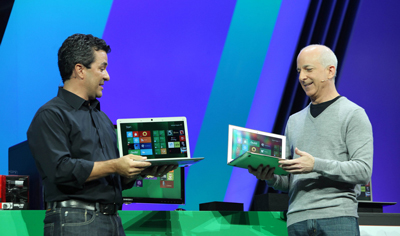News
Microsoft Takes Windows 8 Out for a Spin in Build Keynote
- By Michael Desmond
- September 13, 2011
Windows 8 was king at Tuesday's Build keynote led by Steven Sinofsky, president of Microsoft's Windows and Windows Live Division.
Attendees of the long-awaited development conference, taking place this week in Anaheim, Calif., were treated to a glimpse into the developer preview version of Windows 8 (set to go live Tuesday night) and a tour of various hardware devices destined to run the new OS.
Sinofsky said Microsoft focused on creating a "fast and fluid" experience in Windows 8, while emphasizing the richness that can occur when applications become fully aware of each other.
"What we set out to do is not what you see with so many other platforms where the apps are these silos and they barely know about each other. They go through tiny APIs to do things," Sinofsky said. "We have this bold notion that apps should work together as a web of apps. That when you get additional apps the system gets richer and richer."
Microsoft Corporate Vice President of Windows Experience Julie Larson-Green demoed the new Metro-inspired UI of Windows 8, showing off many of the touch- and gesture-based features first seen at a pair of industry conferences in June.
The demo kicked off with Larson-Green authenticating onto a Windows 8 PC using the new Picture Password feature, which accepts touch and gesture inputs rather than keyboard characters to authenticate the user. Larson-Green then demonstrated how users can navigate the panel-based interface, swiping between screens and zooming in and out of screen elements.
She also showed off Windows 8 "charms," a set of five icons (Search, Share, Start, Devices and Settings) that are accessed by swiping from the right edge of the screen. The charms provide access to application and system functionality previously nested within the Start button in Windows 7. (See this article for more information.)
The new expanded Search feature reaches beyond traditional desktop and Web search to provide context-savvy search of applications, as well as to plumb user-connected services like Facebook, Flickr and Twitter. Share functionality exposes what Sinofsky called "a semantically rich clipboard" for applications to share content with each other.
Said Sinofsky: "You don't have to try figure out how to get connected to everything else, we'll help you do that through sharing contracts."
Hardware Madness
Michael Angiulo, corporate vice president of Windows Planning, Hardware & PC Ecosystem, later took the stage to provide an energetic rundown of a variety of Windows 8-ready devices and PCs, ranging from light tablets to a powerhouse PC that produces 4.7-teraflops.
Angiulo also showed off Windows 8's fast and secure boot process, taking a notebook from shut-down to booted-up in just 8 seconds in his demo. "It can boot almost faster than the monitor can start up," Angiulo said.
The biggest round of applause came when Sinofsky and Angiulo announced that all attendees would receive a Samsung Windows Developer Preview PC. This tablet system is loaded with developer preview versions of Windows 8, Visual Studio and other tools and applications to let developers work with the emerging platforms and technologies.

|
| Angiulo (left) and Sinofsky (right) demonstrate how Windows 8 works across a spectrum of devices. Source: Microsoft |
The Developer Story
Sinofsky also dove into the development infrastructure driving Windows 8 application development. He noted the siloed structure of development across the Web and how Windows 8 is poised to change that.
"We've got the C#and VB world built on top of .NET and Silverlight, we've got the C and the C++ world built on the strong Win32 API, and then we built the silo of HTML and JavaScript built on top of Internet Explorer," Sinofsky said of Windows 7, adding, "The Windows 8 platform lets you pick the language you want to use to build your applications."
Windows RT provides 1,800 objects for building applications, said Sinofsky, all based on native code and built to reflect in different languages. The native Windows RT API and objects reflect into C, C++, C#, Visual Basic and JavaScript, enabling developers to define views in XAML or HTML as they wish.
"We've done a huge amount of work to reimagine the whole way that we think of tools, languages and the platform, so they call come together as a unified story for you," he said.
Antoine Leblond, senior vice president of Windows Web Services, then came on stage to build an HTML 5 application using a developer preview of Visual Studio 11 Express. The demo showed how Visual Studio provides equivalent template support across all the supported languages.
"You are going to get the same templates in each one," Sinofsky interjected. "The Windows RT just supports all the languages out of the gate."
Leblond also showed off HTML support in the developer preview of Expression Blend. "Blend is a tool for editing XAML, not a tool for editing HTML. Well, the new version of Blend can take all the great stuff it can do in XAML and is able to do it in HTML and CSS, as well," Leblond said.
Leblond also showed how applications can be surfaced on the Windows Store using a simple, template-based process that is embedded within Visual Studio 11. "We are going to have a certification process for applications," said Leblond, who also showed a certification status screen that provides information on where an application is in the process.
Sinofsky said that the Windows Store will have support for Metro-style applications and Win32-based programs.
A video of the full keynote is currently available for replay on the Build Web site here.
More from Build:
About the Author
Michael Desmond is an editor and writer for 1105 Media's Enterprise Computing Group.